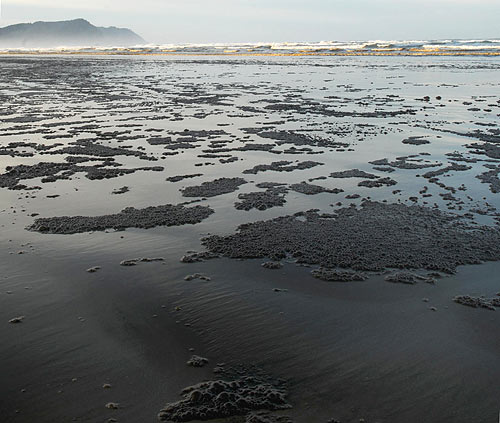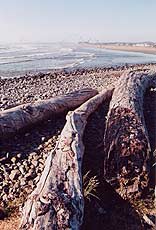 |
Mystery Barrel and More Alarm Over Brown Waves on North Oregon Coast
Published 11/17/2010

(Seaside, Oregon) – A mysterious barrel with an unknown liquid and a call to authorities about a possible oil spill on the coast lead to an interesting coincidence, while in the same few hours a U.S. Coast Guard helicopter is seen making some surprising moves (brown waves photo by Tiffany Boothe, Seaside Aquarium).
Tiffany Boothe, with the Seaside Aquarium, fielded a call Tuesday from a Portland media outlet that someone had reported an oil spill in the area. Boothe laughed a little to herself, and sent off the explanation to the TV station. It’s a question locals in Seaside get a lot, as periodically the waves turn an odd brown and there are oily looking spots on the beach.

Photo Tiffany Boothe, Seaside Aquarium
It's a form of phytoplankton called diatoms, she said. She then called her boss at the aquarium, Keith Chandler.
“I just called Keith to laugh about it,” Boothe said. “Then he told me there actually was what looked like an oil barrel found at the Cove in Seaside.”
 |
| Seaside's cove area |
Boothe said she went to check out the object herself, and there was a small amount of liquid in the drum.
“There was a kind of sheen in a pool of water next to it,” Boothe said.
She was careful to point out she didn’t actually identify the liquid. She called authorities about it, and the last she heard was that the U.S. Coast Guard would be taking care of it, likely with hazmat suits.
The U.S. Coast Guard office in Astoria confirmed that they received a call, but workers from Oregon State Parks and Recreation Department has retrieved the object. There is no identification yet on the liquid inside.
Boothe said the metallic drum was just a coincidence. The culprit behind the brown surf is the same as always: diatoms.
“Diatoms are single-celled plants (phytoplankton) that are found in both fresh and salt water,” Boothe said. “They are responsible for turning the surf brown and staining the sand.”
When there is such an abundance of them, the surf gets colored.
They are the bottom of the food chain: everything in the ocean feeds on diatoms and other plankton, either directly or indirectly. This is the main course for whales, on a consistent basis. In fact, the tiny, microscopic skeletons of these critters are partially responsible for the sea foam that is present on beaches. Air that creates bubbles through these skeletons – in the form of foam – is the other main element.
The area from Tillamook Head to the Columbia River is thick with nutrients that feed diatoms, so there are more of them. Boothe said the brown gets thicker the farther north you go towards Warrenton.
 |
| A US Coast Guard helicopter searches close to Manzanita's Neahkahnie Mountain |
Meanwhile, in the Manzanita area, a U.S. Coast Guard helicopter was apparently searching for someone in the surf in the rough waters right below Neahkahnie Mountain on Tuesday afternoon. The helicopter was seen moving quite close to the mountain, just below the overlooks, scanning the large breakers on the rocky stretch that lines the bottom of the mountain.
Sheriffs deputies were parked on the overlooks themselves.
The U.S. Coast Guard could not comment on what they were looking for, saying that they were working with Tillamook County Sheriffs. No one from the sheriff’s office was available for comment on Tuesday night.
Aside from brown waves, much of the coast is still seeing loads of interesting objects washing up, such as tons of bull kelp, jellyfish, and other critters from the deep. (Below: bull kelp at Gearhart)
More About Oregon Coast hotels, lodging.....
 |
 |
LATEST OREGON COAST NEWS STORIES
Decay Hits Beloved Oregon Coast Tree, Now the Newport Icon Must Be Cut Down |
Back to Oregon Coast
Contact Advertise on BeachConnection.net
Secrets of the Season |
Unusual Travel Articles TravelParanormal.com allows you to submit your own creepy tale or debunk one - or see up-to-the-minute news headlines about travel and the paranormal. News Headlines from All Over Oregon Need to scan Oregon headlines? Constantly updated news from all over Oregon: a comprehensive, up-to-the-minute display of news headlines from a variety of media |






































